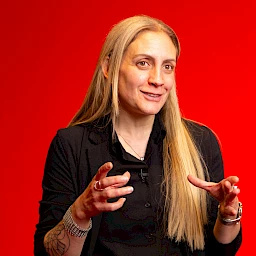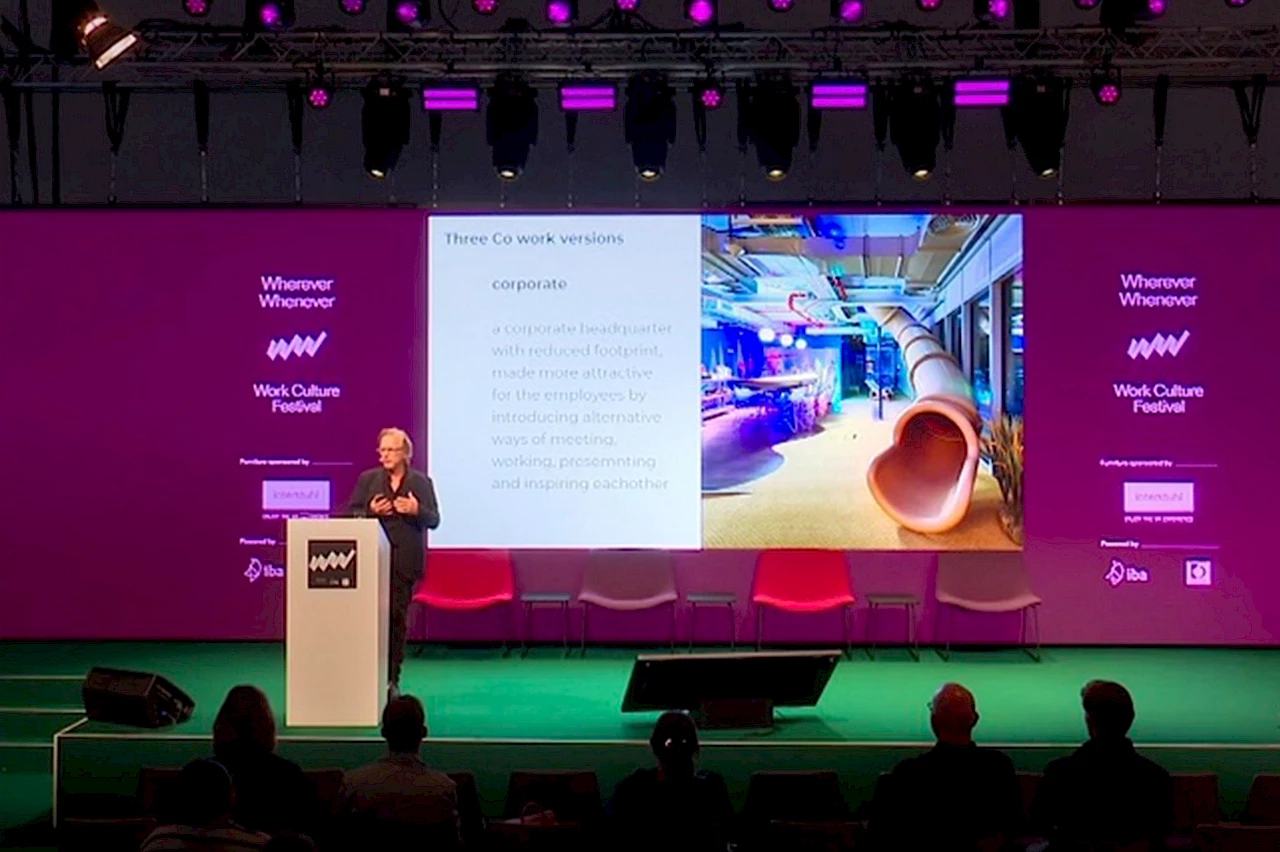How can we shape the spaces of the changing world of work? What role does co-working play at a time when flexibility, diversity of use and quality of life are becoming increasingly important? For Maarten Jamin, it’s clear that the future of work lies in sharing models. In his presentation at the Work Culture Festival, the Chief Design Officer at IWG and co-founder of the Dutch creative collective bs;bp argued for a radically expanded understanding of co-working: not as desk sharing, but as a platform for community, context, cooperation and co-existence. Using concrete examples, he showed how these principles could change architecture, urban development and corporate culture.
Three types, one idea: sharing creates added value
Co-working has become more diverse and this is precisely where its strength lies. Jamin distinguishes between three main forms, each of which takes different needs into account, but which are all based on the principle of sharing.
In corporate co-working, companies redesign their own office spaces as open, community-oriented working environments. In addition to a more efficient use of space, the main aim here is to enhance a location as a social place and promote internal cooperation.
Multi-tenant co-working brings self-employed people, start-ups and established companies together under one roof. The shared spaces offer economic benefits, but also the opportunity for chance encounters, new collaborations and mutual inspiration, provided the spaces are designed accordingly and the interaction is actively moderated.
Stand-alone co-working spaces, in turn, offer work opportunities close to home as a third option, besides offices and homes. They reduce commuting times, increase the quality of life and strengthen local neighbourhoods. They are often integrated into neighbourhood concepts that take mixed use into account and act as a stimulus for the revitalisation of the surrounding area.
What all these models have in common is their stance: Work is no longer linked to ownership, but to access. Co-working thus exemplifies a social development towards a sharing economy, resource efficiency and social participation.
Transforming workplaces to usage platforms
This development is being accelerating by the economic pressure on the property market. In view of rising vacancy rates and falling office occupancy, owners are looking for new concepts. Jamin speaks openly about the “anxiety in the sector”: Many properties are losing market value because traditional usage patterns are no longer effective. Co-working offers the opportunity to use space flexibly and monetise it further. At the same time, user expectations are changing. Instead of “9 to 5” jobs, people are looking for inspiring environments that combine quality of life and flexibility. As a result, today’s co-working spaces have to be much more than just functional workplaces. They are platforms for communication, learning, services and social interaction.
Please also read

Mixed use as a model for the future
One approach that is becoming increasingly important in the discussion about sustainable forms of work is the mixed use of buildings. In his presentation, Maarten Jamin presented international examples in which co-working is deliberately combined with other functions, such as market halls with integrated office space, residential buildings with publicly accessible work lounges or cafés with attached childcare and bicycle repair shops. One particularly vivid example comes from the London borough of Peckham. An entire building there was designed to combine restaurants, event spaces, workplaces and residential units under one roof to enable round-the-clock use. The basic idea is that instead of monofunctional properties, multifunctional places are created that can respond to different needs. Such concepts increase the economic utilisation and social relevance of a location. They create a lively environment with a high quality of stay wherever working, learning, culture, local amenities and neighbourly feeling come together. For planners, this means that future-oriented architecture goes beyond the individual workplace and takes a variety of uses into account from the very start, even in the floor plan.
Flexibility needs structure
But how can this be put into practice? Jamin advocates a new generation of spatial concepts that allow maximum changeability without becoming arbitrary. He calls this the principle of “invisible lines on the floor”: clear grids, modular furniture and adaptive floor plans that can be quickly repurposed as required. From an individual office to a learning lounge, from a meeting room to an exhibition. In a short time and with a few simple steps. What is important here is a smart basic structure that provides orientation and facilitates changes without requiring structural measures every time. One example is the Vitra Koma system, which allows rooms to be completely reorganised within a day. “Like a Lego set with instructions,” says Jamin. It’s a modular principle for interior design that enables users to actively shape their own environment. This self-empowerment is essential: People who can flexibly adapt their environment to their own way of working feel not only more comfortable but also taken seriously. Flexibility thus becomes a cultural and spatial quality and is an invitation to participation and shared responsibility. Jamin emphasises that “The future does not belong to static room programmes, but to dynamic usage logics.” Rooms don’t have to be perfect for one purpose, but good enough for many purposes and easy to change. This does not require technical overkill, but a well thought-out interplay of design, functionality and user guidance.
Co-working as a community task
It takes more than just good design to prevent these spaces from becoming anonymous “desk filling stations”. In the long run, co-working only works if it is designed and operated as social infrastructure. Jamin emphasises that “Architecture can provide the framework—with open zones, meeting areas and identity-forming materials.” But what makes a place come alive is the interaction between people. You need community management that not only handles organisation, but also inspires. You need people on site to curate programmes, promote networks and facilitate targeted exchanges. Formats such as breakfast rounds, TED talks, after-work sessions and pop-up exhibitions not only create variety, but also lower the inhibition threshold for making contact. They transform random proximity in shared spaces into actual connections. This is particularly crucial in multi-tenant contexts, where users come from completely different industries and backgrounds. The person at the next table may not be a colleague, but perhaps a future partner or customer and definitely an interesting conversation partner.
That’s why co-working requires a culture of sharing, listening and co-creating. Openness, trust and curiosity can’t be expected to arise automatically, but must be specifically encouraged and cultivated. The “co” in co-working therefore stands for collaboration, community, context and co-creation. It is not a secondary aspect, but the central task for everyone who develops and operates such places.





